新编简明英语语言学教程 第二版 戴炜栋4 Syntax
《语言学》Chapter 4 Syntax 习题兼答案
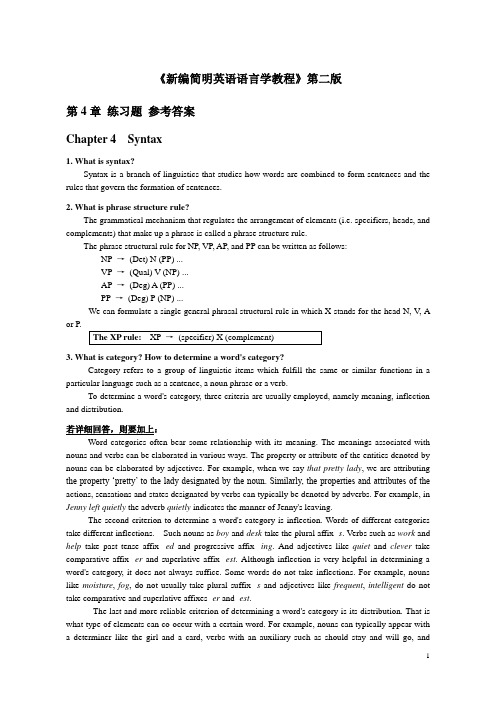
《新编简明英语语言学教程》第二版第4章练习题参考答案Chapter 4 Syntax1. What is syntax?Syntax is a branch of linguistics that studies how words are combined to form sentences and the rules that govern the formation of sentences.2. What is phrase structure rule?The grammatical mechanism that regulates the arrangement of elements (i.e. specifiers, heads, and complements) that make up a phrase is called a phrase structure rule.The phrase structural rule for NP, VP, AP, and PP can be written as follows:NP →(Det) N (PP) ...VP →(Qual) V (NP) ...AP →(Deg) A (PP) ...PP →(Deg) P (NP) ...We can formulate a single general phrasal structural rule in which X stands for the head N, V, A or P.3. What is category? How to determine a word's category?Category refers to a group of linguistic items which fulfill the same or similar functions in a particular language such as a sentence, a noun phrase or a verb.To determine a word's category, three criteria are usually employed, namely meaning, inflection and distribution.若详细回答,则要加上:Word categories often bear some relationship with its meaning. The meanings associated with nouns and verbs can be elaborated in various ways. The property or attribute of the entities denoted by nouns can be elaborated by adjectives. For example, when we say that pretty lady, we are attributing the property ‘pretty’ to the lady designated by the noun. Similarly, the properties and attributes of the actions, sensations and states designated by verbs can typically be denoted by adverbs. For example, in Jenny left quietly the adverb quietly indicates the manner of Jenny's leaving.The second criterion to determine a word's category is inflection. Words of different categories take different inflections. Such nouns as boy and desk take the plural affix -s. Verbs such as work and help take past tense affix -ed and progressive affix -ing. And adjectives like quiet and clever take comparative affix -er and superlative affix -est. Although inflection is very helpful in determining a word's category, it does not always suffice. Some words do not take inflections. For example, nouns like moisture, fog, do not usually take plural suffix -s and adjectives like frequent, intelligent do not take comparative and superlative affixes -er and -est.The last and more reliable criterion of determining a word's category is its distribution. That is what type of elements can co-occur with a certain word. For example, nouns can typically appear with a determiner like the girl and a card, verbs with an auxiliary such as should stay and will go, andadjectives with a degree word such as very cool and too bright.A word's distributional facts together with information about its meaning and inflectional capabilities help identify its syntactic category.4. What is coordinate structure and what properties does it have?The structure formed by joining two or more elements of the same type with the help of a conjunction is called coordinate structures.It has (或写Conjunction exhibits) four important properties:1) There is no limit on the number of coordinated categories that can appear prior to the conjunction.2) A category at any level (a head or an entire XP) can be coordinated.3) Coordinated categories must be of the same type.4) The category type of the coordinate phrase is identical to the category type of the elements beingconjoined.5. What elements does a phrase contain and what role does each element play?A phrase usually contains the following elements: head, specifier and complement. Sometimes it also contains another kind of element termed modifier.The role each element can play:Head:Head is the word around which a phrase is formed.Specifier:Specifier has both special semantic and syntactic roles. Semantically, it helps to make more precise the meaning of the head. Syntactically, it typically marks a phrase boundary.Complement:Complements are themselves phrases and provide information about entities and locations whose existence is implied by the meaning of the head.Modifier:Modifiers specify optionally expressible properties of the heads.6. What is deep structure and what is surface structure?There are two levels of syntactic structure. The first, formed by the XP rule in accordance with the head's subcategorization properties, is called deep structure(or D-structure). The second, corresponding to the final syntactic form of the sentence which results from appropriate transformations, is called surface structure (or S-structure).(以下几题只作初步的的成分划分,未画树形图, 仅供参考)7. Indicate the category of each word in the following sentences.a) The old lady got off the bus carefully.Det A N V P Det N Advb) The car suddenly crashed onto the river bank.Det N Adv V P Det Nc) The blinding snowstorm might delay the opening of the schools.Det A N Aux V Det N P Det Nd) This cloth feels quite soft.Det N V Deg A8. The following phrases include a head, a complement, and a specifier. Draw the appropriatetree structure for each.a) rich in mineralsXP(AP) →head (rich) A + complement (in minerals) PPb) often read detective storiesXP(VP) →specifier (often) Qual +head (read) V +complement (detective stories) NPc) the argument against the proposalsXP(NP) →specifier (the) Det +head (argument) N +complement (against the proposals) PP d) already above the windowXP(VP) →specifier (already) Deg +head (above) P +complement (the window) NPd) The apple might hit the man.S →NP (The apple) + Infl (might) +VP (hit the man)e) He often reads detective stories.S →NP (He) +VP (often reads detective stories)9. The following sentences contain modifiers of various types. For each sentence, first identify the modifier(s), then draw the tree structures.(斜体的为名词的修饰语,划底线的为动词的修饰语)a) A crippled passenger landed the airplane with extreme caution.b) A huge moon hung in the black sky.c) The man examined his car carefully yesterday.d) A wooden hut near the lake collapsed in the storm.10. The following sentences all contain conjoined categories. Draw a tree structure for each of the sentences.(划底线的为并列的范畴)a) Jim has washed the dirty shirts and pants.b) Helen put on her clothes and went out.c) Mary is fond of literature but tired of statistics.11. The following sentences all contain embedded clauses that function as complements of a verb, an adjective, a preposition or a noun. Draw a tree structure for each sentence.a) You know that I hate war.b) Gerry believes the fact that Anna flunked the English exam.c) Chris was happy that his father bought him a Rolls-Royce.d) The children argued over whether bats had wings.12. Each of the following sentences contains a relative clause. Draw the deep structure and the surface structure trees for each of these sentences.a) The essay that he wrote was excellent.b) Herbert bought a house that she lovedc) The girl whom he adores majors in linguistics.13. The derivations of the following sentences involve the inversion transformation. Give the deep structure and the surface structure of each of these sentences. (斜体的为深层结构,普通字体的为表层结构)a) Would you come tomorrow?you would come tomorrowb) What did Helen bring to the party?Helen brought what to the partyc) Who broke the window?who broke the window。
chapter 4 syntax 简明英语语言学 戴炜栋
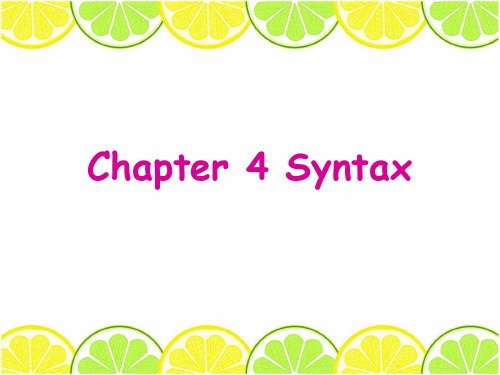
3.3 IC Analysis (直接成分分析法) immediate constituent(直接成分)
Constituent (构成成分) ultimate constituent (最终成分)
IC(直接成分): Can be further segmented until we obtain the smallest grammatical units. UC(最终成分): The smallest grammatical unit obtained through segmentation.
2.2.1 Concord/agreement(一致关系)
A verb is to agree with the subject in person and in number. In English, this rule only affects the verb according to the number of the subject.
This principle refers to the rule that the verb can sometimes agree with the subject according to the notion of number rather than to the actual presence of the grammatical marker for that notion. e.g The government have asked the country to decide by a vote The new military government does not have popular support.
subject subject
戴炜栋《新编简明英语语言学教程》(第2版)章节题库(第4~6章)【圣才出品】

戴炜栋《新编简明英语语言学教程》(第2版)章节题库第4章句法学I.Multiple choices:1.Among the branches of linguistics,______studies how words are combined to form sentences and the rules that govern the formation of sentences.A.syntaxB.semanticsC.pragmaticsD.morphology【答案】A【解析】句法学研究的是句子结构;词、词组和短语组成句子的规则。
B项为语义学,C 选项为语用学,D选项为形态学均不符合题意。
因此,本题的正确答案为A。
2.In traditional grammar,only eight categories,called parts of speech,arerecognized.The addition of such non-traditional categories as______increases this number in current theories of grammar.A.conjunction and determinerB.determiner and qualifierC.qualifier and interjectionD.interjection and degree words【答案】B【解析】传统语法只承认8种范畴,称为词类,分别为名词、动词、形容词、介词、副词、冠词、连词、代词,但当今的语法理论增加了一些非传统的范畴,如:限定词determiner、程度词degree word和修饰词qualifier。
因此,本题的正确答案为B。
3.Which of the following is NOT the element that phrases formed of more than one word usually contain?A.Head.B.Specifier.C.Word category.plement.【答案】C【解析】由多个单词构成的短语通常包括:中心语、标志语和补语。
chapter syntax 简明英语语言学 戴炜栋
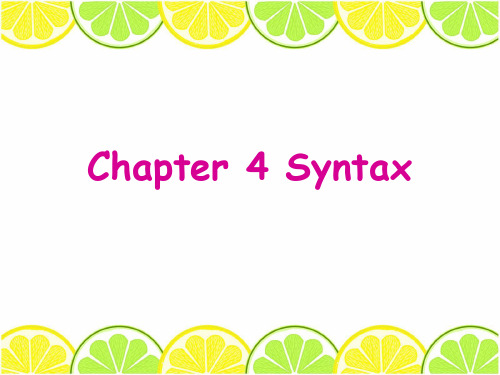
1) Grammatical concord(语法一致原则)
This principle refers to the rule that the verb must match its subject in number.
Fifteen miles seems like a long walk to me. Fifty-six dollars was stolen from the cash register.
3) Principle of Proximity(就近原则)
This principle denotes agreement of the verb with a closely preceding noun phrase. (there be, or, either…or, neither…nor, not only… but also, whether … or … ) e.g There is a pen, a few envelops and some paper for you.
Chapter 4 Syntax
1.What is syntax?
• A branch of linguistics that studies how words are combined to form sentences and the rules that govern the formation of sentences.
Either my brothers or my father is coming. Not only you but also he is wrong. Neither Tom nor I am a student.
戴炜栋《新编简明英语语言学教程》(第2版)课后习题详解(中)【圣才出品】

戴炜栋《新编简明英语语⾔学教程》(第2版)课后习题详解(中)【圣才出品】第4章句法学1. What is syntax?Key: Syntax is a branch of linguistics that studies the rules that governs the formation of sentences.2. What is phrase structure rule?Key: The special type of grammatical mechanism that regulates the arrangement of elements that make up a phrase is calleda phrase structure rule.3. What is category? How to determine a word’s category?Key: Category refers to a group of linguistic items which fulfill the same or similar functions in a particular language such as a sentence, a noun phrase or a verb. T o determine a word’s category, three criteria are usually employed, namely, meaning, inflation and distribution.4. What is coordinate structure? What properties does it have?Key: The structures that are formed by joining two or more elements of the same type with the help of a conjunction are called coordinate structures. It has four properties: first, there is no limit on the number of coordinated categories. Second, a category at any level can be coordinated. Third, coordinated categories must be of the same type. Fourth, the category type of the coordinate phrase isidentical to the category type of the elements being conjoined.5. What elements does a phrase contain and what rule does each element play? Key: The phrase elements are specifiers, complements and modifiers. Specifiers help make more precise the meaning of the head. They typically mark a phrase. The complements provide information about entities and locations whose existence is implied by the meaning of the head. Modifiers specifies optionally expressible properties of heads.6. What is deep structure and what is surface structure?Key: The structure that formed by the XP rule in accordance with the head’s subcategorization properties is called the deep structure. The structure that corresponds to the final syntactic form of the sentence which results from appropriate transformation is called surface structure.7. Indicate the category of each word in the following sentences.a) The old lady got off the bus carefully.b) The car suddenly crashed onto the river bank.c) The blinding snowstorm might delay the opening of the school.d) This cloth feels quite soft.Key:8. The following phrases include a head, a complement, and a specifier. Draw the appropriate tree structure for each.a) rich in mineralsb) often read detective storiesc) an augment against the proposalsd) already above the windowKey: a) rich in mineralsb) often read detective storiesc) the argument against the proposalsd) already above the window9. The following sentences contain modifiers of various types. For each sentence, first identify the modifier(s), then draw the tree structures.a) A crippled passenger landed the airplane with extreme caution.b) A huge moon hung in the black sky.c) The man examined his car carefully yesterday.d) A wooden hut near the lake collapsed in the storm.Key: (The modifiers are represented by italics.)a) A crippled passenger landed the airplane with extreme caution.b) A huge moon hung in the black sky.c) The man examined his car carefully yesterday.d) A wooden hut near the lake collapsed in the storm.10. The following sentences all contain conjoined categories. Draw a tree structure for each of the sentences.a) Jim has washed the dirty shirts and pants.b) Helen put on her clothes and went out.c) Mary is fond of literature but tired of statistics.Key: a) Jim has washed the dirty shirts and pants.b) Helen put on her clothes and went out.c) Mary is fond of literature but tired of statistics.11. The following sentences all contain embedded clauses that function ascomplements of a verb, an adjective, a preposition or a noun. Draw a tree structure for each sentence.a) You know that I hate war.b) Gerry can’t believe the fact that Anna flunked the English exam.c) Chris was happy that his father bought him a Rolls-Royce.d) The children argued over whether bats had wings.Key: a) You know that I hate war.。
圣才教育:戴炜栋《新编简明英语语言学教程》

内容摘要
实用性:这本书不仅注重理论知识的学习,还强调实际应用能力的培养。每一章节都附有大量实 例和案例分析,帮助学生更好地理解和掌握语言学知识。书中的关键词和思考题也为学生提供了 实际应用的指导。 时代性:这本书的内容紧跟时代步伐,反映了当今语言学研究的前沿。它不仅介绍了最新的语言 学理论和研究成果,还涉及了语言与文化、社会、认知等领域的交叉研究,有助于学生拓宽视野, 了解学科前沿。 内容丰富:这本书涵盖了语言学的各个方面,包括语音、词汇、语法、语义、语用等基础理论知 识和应用。同时,它还涉及了二语习得和语言习得的理论和实践,使得学生能够全面了解语言学 及应用。
该章节介绍了计算机与语言的、计算机与自然语言处理的关系以及自然语言处 理的基本任务和应用领域。
该章节介绍了认知科学的定义、认知科学的学科交叉性、语言与认知的关系以 及认知语言学的定义和基本原理。
该章节介绍了隐喻和转喻的定义、隐喻和转喻的认知功能以及隐喻和转喻在英 语词汇和表达中的应用。
该章节介绍了文化的定义、文化与语言的关系以及文化适应和文化休克的概念。 同时,还介绍了跨文化交际能力和跨文化意识的培养方法。
精彩摘录
语言是人类最重要的交际工具,是音义结合的符号系统。
语言的音和义、语素和词汇的意义是约定俗成的,语言的音义之间没有必然的 关系。
语言的底层是一套音位和音位的组合规则;上层是音义结合的语言符号。
语言具有创造性,它能够产生并理解无限量的语句。
语言具有创造性,它能够产生并理解无限量的语句。
该章节介绍了形态学的定义、词素和词根、词干和词缀、屈折变化和派生变化、 复合词和短语以及形态学在自然语言处理中的应用。
该章节介绍了句法学的定义、语法和句法的关系、短语、句子和句法结构、句 法规则的类型和应用、转换语法和句法分析的基本原则以及句法学在自然语言 处理中的应用。
06422英语语言学—新编简明英语语言学教程,戴炜栋

06422英语语言学—新编简明英语语言学教程,戴炜栋06422英语语言学—新编简明英语语言学教程, 戴炜栋ContentsChapter 1 Introduction (1)Chapter 2 Phonology (5)Chapter 3 Morphology (8)Chapter 4 Syntax (9)Chapter 5 Semantics (12)Chapter 6 Pragmatics (16)Chapter 7 Historical linguistics (19)Chapter 8 Sociolinguistics (24)Chapter 9 Psycholinguistics (29)Chapter 10 Language Acquisition (32)Chapter 1 Introduction一、定义1.语言学LinguisticsLinguistics is generally defined as the scientific study of language.2.普通语言学General LinguisticsThe study of language as a whole is often called General linguistics.3.语言languageLanguage is a system of arbitrary vocal symbols used for human communication.语言是人类用来交际的任意性的有声符号体系。
4.识别特征Design FeaturesIt refers to the defining properties of human language that distinguish it from any animal system of communication.语言识别特征是指人类语言区别与其他任何动物的交际体系的限定性特征。
戴炜栋《新编简明英语语言学教程》(第2版)课后习题详解(第4章 句法学——第6章 语用学)【圣才出品

第4章句法学1. What is syntax?Key: Syntax is a branch of linguistics that studies the rules that governs the formation of sentences.2. What is phrase structure rule?Key: The special type of grammatical mechanism that regulates the arrangement of elements that make up a phrase is called a phrase structure rule.3. What is category? How to determine a word’s category?Key: Category refers to a group of linguistic items which fulfill the same or similar functions in a particular language such as a sentence, a noun phrase or a verb. T o determine a word’s category, three criteria are usually employed, namely, meaning, inflation and distribution.4. What is coordinate structure? What properties does it have?Key: The structures that are formed by joining two or more elements of the same type with the help of a conjunction are called coordinate structures. It has four properties: first, there is no limit on the number of coordinated categories. Second, a category at any level can be coordinated. Third, coordinated categories must be of the same type. Fourth, the category type of the coordinate phrase isidentical to the category type of the elements being conjoined.5. What elements does a phrase contain and what rule does each element play? Key: The phrase elements are specifiers, complements and modifiers. Specifiers help make more precise the meaning of the head. They typically mark a phrase. The complements provide information about entities and locations whose existence is implied by the meaning of the head. Modifiers specifies optionally expressible properties of heads.6. What is deep structure and what is surface structure?Key: The structure that formed by the XP rule in accordance with the head’s subcategorization properties is called the deep structure. The structure that corresponds to the final syntactic form of the sentence which results from appropriate transformation is called surface structure.7. Indicate the category of each word in the following sentences.a) The old lady got off the bus carefully.b) The car suddenly crashed onto the river bank.c) The blinding snowstorm might delay the opening of the school.d) This cloth feels quite soft.Key:8. The following phrases include a head, a complement, and a specifier. Draw the appropriate tree structure for each.a) rich in mineralsb) often read detective storiesc) an augment against the proposalsd) already above the windowKey: a) rich in mineralsb) often read detective storiesc) the argument against the proposalsd) already above the window9. The following sentences contain modifiers of various types. For each sentence, first identify the modifier(s), then draw the tree structures.a) A crippled passenger landed the airplane with extreme caution.b) A huge moon hung in the black sky.c) The man examined his car carefully yesterday.d) A wooden hut near the lake collapsed in the storm.Key: (The modifiers are represented by italics.)a) A crippled passenger landed the airplane with extreme caution.b) A huge moon hung in the black sky.c) The man examined his car carefully yesterday.d) A wooden hut near the lake collapsed in the storm.10. The following sentences all contain conjoined categories. Draw a tree structure for each of the sentences.a) Jim has washed the dirty shirts and pants.b) Helen put on her clothes and went out.c) Mary is fond of literature but tired of statistics.Key: a) Jim has washed the dirty shirts and pants.b) Helen put on her clothes and went out.c) Mary is fond of literature but tired of statistics.11. The following sentences all contain embedded clauses that function ascomplements of a verb, an adjective, a preposition or a noun. Draw a tree structure for each sentence.a) You know that I hate war.b) Gerry can’t believe the fact that Anna flunked the English exam.c) Chris was happy that his father bought him a Rolls-Royce.d) The children argued over whether bats had wings.Key: a) You know that I hate war.。
新编简明英语语言学教程 第二版 戴炜栋4 Syntax
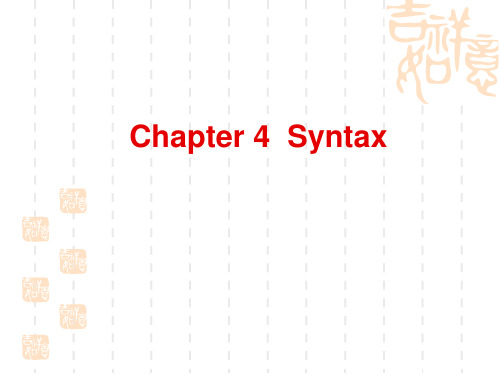
Criteria on good grammar
Observational adequacy Descriptive adequacy Explanatory adequacy The ultimate goal for any theory is to explain. TG differs from traditional grammar in that it not only aims at language description, but also its explanation.
Chapter 4 Syntax
What is syntax?
----a branch of linguistics that studies how words are combined to form sentences and the rules that govern the formation of sentences.
Transformational Generative Grammar (TG) Norm. Chomsky, the most influential linguist in 20th century, some important works: (1957) Syntactic Structure; (1965) Aspects of the Theory of Syntax; (1981) Lectures on Government and Binding; (1986) Barriers (1993) A Minimalist Program for Linguistic Theory; (1995) The Minimalist Program; (1998) The Minimalist Inquiry……
新编简明英语语言学教程戴炜栋第1-3章课后练习题答案

《新编简明英语语言学教程》第二版第1-3章练习题参考答案Chapter 1 IntroductionP131. How do you interpret the following definition of linguistics: Linguistics is the scientific study of language ?答:Linguistics is based on the systematic investigation of linguistic data, conducted with reference to some general theory of language structure. In order to discover the nature and rules of the underlying language system, the linguists has to collect and observe language facts first, which are found to display some similarities, and generalizations are made about them; then he formulates some hypotheses about the language structure. The hypotheses thus formed have to be checked repeatedly against the observed facts to fully prove their validity. In linguistics, as in any other discipline, data and theory stand in a dialectical complementation, that is, a theory without the support of data can hardly claim validity, and data without being explained by some theory remain a muddled mass of things.2. What are the major branches of linguistics? What does each of them study?答: The major branches of linguistics are:(1) phonetics: it studies the sounds used in linguistic communication;(2) phonology: it studies how sounds are put together and used to convey meaning in communication;(3) morphology: it studies the way in which linguistic symbols representing sounds are arranged and combined to form words;(4) syntax: it studies the rules which govern how words are combined to form grammatically permissible sentences in languages;(5) semantics: it studies meaning conveyed by language;(6) pragmatics: it studies the meaning in the context of language use.3. In what basic ways does modern linguistics differ from traditional grammar?答: The general approach thus traditionally formed to the study of language over the years is roughly referred to as “ditional grammar. ” Modern linguistics differs from traditional grammar in several basic ways.Firstly, linguistics is descriptive while traditional grammar is prescriptive.Second, modem linguistics regards the spoken language as primary, not the written. Traditional grammarians, on the otherhand, tended to emphasize, maybe over-emphasize, the importance of the written word, partly because of its permanence.Then, modem linguistics differs from traditional grammar also in that it does not force languages into a Latin-based framework.4. Is modern linguistics mainly synchronic or diachronic? Why?答: In modem linguistics, a synchronic approach seems to enjoy priority over a diachronic one. Because people believed thatunless the various states of a language in different historical periods are successfully studied, it would be difficult to describe the changes that have taken place in its historical development.5. For what reasons does modern linguistics give priority to speech rather than to writing?答: Speech and writing are the two major media of linguistic communication. Modem linguistics regards the spoken languageas the natural or the primary medium of human language for some obvious reasons. From the point of view of linguistic evolution, speech is prior to writing. The writing system of any langu age is always a invented ” by its users to record speech when the need arises. Even in today's world there are still many languages that can only be spoken but not written. Then in everyday communication, speech plays a greater role than writing in terms of the amount of information conveyed. And also, speech is always the way in which every native speaker acquires his mother tongue, and writing is learned and taught later when he goes to school. For modern linguists, spoken language reveals many true features of human speech while written language is only the"revised ” record of spe. Thus their data for investigation and analysis are mostly drawn from everyday speech, which they regard as authentic.6. How is Saussure's distinction between langue and parole similar to Chomsky's distinction between competence and performance?答:Saussure's distinction and Chomsky's are very similar, they differ at least in that Saussuretook a sociological view of language and his notion of langue is a matter of social conventions, and Chomsky looks at language from a psychological point of view and to him competence is a property of the mind of each individual.7. What characteristics of language do you think should be included in a good, comprehensive definition of language? 答:First of all, language is a system, i.e., elements of language are combined according to rules.Second, language is arbitrary in the sense that there is no intrinsic connection between a linguistic symbol and what the symbol stands for.Third, language is vocal because the primary medium for all languages is sound.Fourth, language is human-specific, i. e., it is very different from the communication systems other forms of life possess.8. What are the main features of human language that have been specified by C. Hockett to show that it is essentially different from animal communication system? (2. 2 语言的识别性特征)美国语言学家 C. Hockett 提出了人类语言的12 种识别性特征,其中最重要的识别性特种有 5 种:即语言的任意性、创造性、二重性、移位性和文化传递性。
戴炜栋《新编简明英语语言学教程》(第2版)笔记和课后习题考研真题
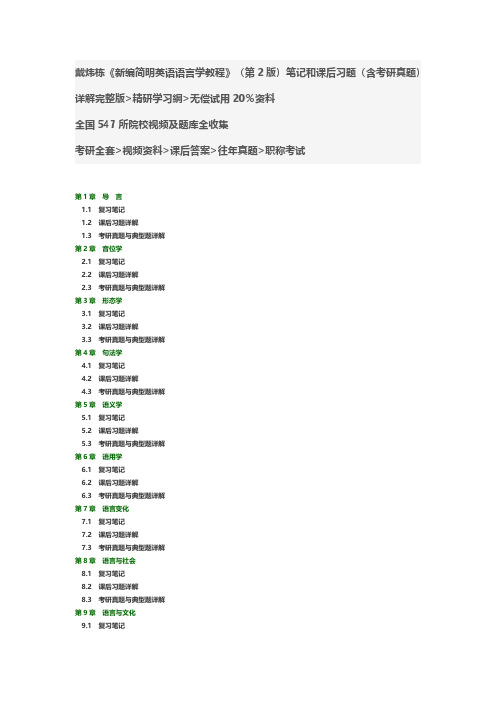
戴炜栋《新编简明英语语言学教程》(第2版)笔记和课后习题(含考研真题)详解完整版>精研学习䋞>无偿试用20%资料
全国547所院校视频及题库全收集
考研全套>视频资料>课后答案>往年真题>职称考试
第1章导言
1.1复习笔记
1.2课后习题详解
1.3考研真题与典型题详解
第2章音位学
2.1复习笔记
2.2课后习题详解
2.3考研真题与典型题详解
第3章形态学
3.1复习笔记
3.2课后习题详解
3.3考研真题与典型题详解
第4章句法学
4.1复习笔记
4.2课后习题详解
4.3考研真题与典型题详解
第5章语义学
5.1复习笔记
5.2课后习题详解
5.3考研真题与典型题详解
第6章语用学
6.1复习笔记
6.2课后习题详解
6.3考研真题与典型题详解
第7章语言变化
7.1复习笔记
7.2课后习题详解
7.3考研真题与典型题详解
第8章语言与社会
8.1复习笔记
8.2课后习题详解
8.3考研真题与典型题详解
第9章语言与文化
9.1复习笔记
9.2课后习题详解
9.3考研真题与典型题详解第10章语言习得
10.1复习笔记
10.2课后习题详解
10.3考研真题与典型题详解第11章第二语言习得
11.1复习笔记
11.2课后习题详解
11.3考研真题与典型题详解第12章语言与大脑
12.1复习笔记
12.2课后习题详解
12.3考研真题与典型题详解。
《新编简明英语语言学教程》第二版_练习题_参考答案txt

《新编简明英语语言学教程》第二版_练习题_参考答案txt新编简明英语语言学教程》第二版练习题参考答案Chapter 1 Introduction2、What are the major branches of linguistics? What does each of them study?答: The major branches of linguistics are:(1) phonetics: it studies the sounds used in linguistic communication;(2) phonology: it studies how sounds are put together and used to convey meaning in communication;(3) morphology: it studies the way in which linguistic symbols representing sounds are arranged and combined to form words;(4) syntax: it studies the rules which govern how words are combined to form grammatically permissible sentences in languages;(5) semantics: it studies meaning conveyed by language;(6) pragmatics: it studies the meaning in the context of language use、Chapter 2 Phonology4、How are the English consonants classified?答: English consonants can be classified in two ways: one is in terms of manner of articulation and the other is in terms of place of articulation、In terms of manner of articulation the English consonants can be classified into the following types: stops, fricatives, affricates, liquids, nasals and glides、In terms of place of articulation, it can be classified into following types: bilabial, labiodental, dental, alveolar, palatal, velar and glottal、5、What criteria are used to classify the English vowels?答: Vowels may be distinguished as front, central, and backaccording to which part of the tongue is held highest、T o further distinguish members of each group, we need to apply another criterion, i、e、the openness of the mouth、Accordingly, we classify the vowels into four groups: close vowels, semi-close vowels, semi-open vowels, and open vowels、A third criterion that is often used in the classification of vowels is the shape of the lips、In English, all the front vowels and the central vowels are unfounded vowels, i、e、, without rounding the lips, and all the back vowels, with the exception of [a:], are rounded、It should be noted that some front vowels can be pronounced with rounded lips、Chapter 3 Morphology4、The italicized part in each of the following sentences is an inflectional morpheme、Study each inflectional morpheme carefully and point out its grammatical meaning、Sue moves in high-society circles in London、A traffic warden asked John to move his car、The club has moved to Friday, February 22nd、The branches of the trees are moving back and forth、答:(1) the third person singular(2) the past tense(3) the present perfect(4) the present progressiveChapter 4 Syntax6、What is deep structure and what is surface structure?There are two levels of syntactic structure、The first, formed by the XP rule in accordance with the head's subcategorization properties, is called deep structure (or D-structure)、The second, corresponding to the final syntactic form of the sentence which results from appropriate transformations, is called surfacestructure (or S-structure)、Chapter 5 Semantics1、What are the major views concerning the study of meaning?答:(1) The naming theory proposed by the ancient Greek scholar Plato、According to this theory, the linguistic forms or symbols, in other words, the words used in a language are simply labels of the objects they stand for、So words are just names or labels for things、(2) The conceptualist view has been held by some philosophers and linguists from ancient times、This view holds that there is no direct link between a linguistic form and what it refers to (i、e、, between language and the real world); rather, in the interpretation of meaning they are linked through the mediation of concepts in the mind、(3) The contextualist view held that meaning should be studied in terms of situation, use, context ––elements closely linked with language behaviour、The representative of this approach was J、R、Firth, famous British linguist、(4) Behaviorists attempted to define the meaning of a language form as the “situation in which the speaker utters it and the response it calls forth in the hearer、” This theory, somewhat close to contextualism, is linked with psychological interest、2、What are the major types of synonyms in English?答: The major types of synonyms are dialectal synonyms, stylistic synonyms, emotive or evaluative synonyms, collocational synonyms, and semantically different synonyms、Examples(略)3、Explain with examples “homonymy”, “polysemy”, and “hyponymy”、答:(1) Homonymy refers to the phenomenon that words having different meanings have the same form, i、e、, different words are identical in sound or spelling, or in both、When two words are identical in sound, they are homophones、When two words are identical in spelling, they are homographs、When two words are identical in both sound and spelling, they are complete homonyms(2) While different words may have the same or similar meaning, the same one word may have more than one meaning、This is what we call polysemy, and such a word is called a polysemic word、There are many polysemic words in English, The fact is the more commonly used a word is, the more likely it has acquired more than one meaning、(3) Hyponymy refers to the sense relation between a more general, more inclusive word and a more specific word、The word which is more general in meaning is called the superordinate, and the more specific words are called its hyponyms、Hyponyms of the same superordinate are co-hyponyms to each other、Hyponymy is a relation of inclusion; in terms of meaning, the superordinate includes all its hyponyms、Examples(略)Chapter 6 PRAGMATICS8、What are the four maxims of the CP? Try to give your own examples to show how floutingthese maxims gives rise to conversational implicature?答: Cooperative Principle, abbreviated as CP、It goes as follows:Make your conversational contribution such as required atthe stage at which it occurs by the accepted purpose or direction of the talk exchange in which you are engaged、T o be more specific, there are four maxims under this general principle:(1) The maxim of quantity①Make your contribution as informative as required (for the current purpose of the exchange)、②Do not make your contribution more informative than is required、(2) The maxim of quality①Do not say what you believe to be false、②Do not say that for which you lack adequate evidence、(3) The maxim of relationBe relevant、(4) The maxim of manner①Avoid obscurity of expression、②Avoid ambiguity、③Be brief (avoid unnecessary prolixity)、④Be orderly、9、What is pragmatic failure? Try to find instances of pragmatic failure in the English used by Chinese learners of English、答: The technical term for breakdowns in the course of communication is pragmatic failure、Pragmatic failure occurs when the speaker fails to use language effectively to achieve a specific communication purpose, or when the hearer fails to recognize the intention or the illocutionary force of the speaker’s utterance in the context of communication、Instances (略) (见教材p、89)Chapter 7 Language Change1、The vocabulary of English consists of native and alsothousands of borrowed words、Look up the following words in a dictionary which provides the etymologies (history) of words、In each case speculate as to how the particular word came to be borrowed from a particular language、a、sizeb、skillc、royald、ranche、robotf、potatog、astronaut h、emerald i、pagodaj、khaki k、bulldoze 1、hoodlum答:a、size (< old French)b、skill (< old Norse)c、royal (< old French < Latin)d、ranch (< Spanish < French)e、robot (< Czech < old Church Slavonic)f、potato (< Spanish < Taino)g、astronaut (< French)h、emerald (< Middle English & old French)i、pagoda (< Persian < Sanskrit)j、khaki (< Hindi <persian)< bdsfid="147" p=""></persian)<>k、bulldoze (< bull(Botany Bay Slang) < old English)l、hoodlum (< German)6、Give at least two examples showing the influence of American English on British English、答:(略)Chapter 8 Language and Society1、How is language related to society?答: There are many indications of the inter-relationshipbetween language and society、One of them is that while language is principally used to communicate meaning, it is also used to establish and maintain social relationships、This social function of language is embodied in the use of such utterances as “Good morning!”, “Hi!”, “How's your family?”, “Nice day today, isn't it?”、Another indication is that users of the same language in a sense all speak differently、The kind of language each of them chooses to use is in part determined by his social background、And language, in its turn, reveals information about its speaker、When we speak, we cannot avoid giving clues to our listeners about ourselves、Then to some extent, language, especially the structure of its lexicon, reflects both the physical and the social environments of a society、For example while there is only one word in English for “snow”, there are several in Eskimo、This is a reflection of the need for the Eskimos to make distinctions between various kinds of snow in their snowy living environment、As a social phenomenon language is closely related to the structure of the society in which it is used, and the evaluation of a linguistic form is entirely social、To a linguist, all language forms and accents are equally good as far as they can fulfill the communicative functions they are expected to fulfill、Therefore, judgments concerning the correctness and purity of linguistic varieties are social rather than linguistic、A case in point is the use of the postvocalic [r]、While in English accents without postvocalic [r] are considered to be more correct than accents with it, in New York city, accents with postvocalic [r] enjoys more prestige and are considered more correct than without it、Chapter 9 Language and Culture1、Try to sum up the relation between language and culture、Can you find similar relationship between local dialect and regional culture?答: The relation between language and culture is dialectical、Every language is part of a culture、As such, it cannot but serve and reflect cultural needs、Within tile broad limits set by the specific needs of a culture, a language is free to make arbitrary selections of signified、That is to say, language is not a passive reflector of culture、Even assuming that culture is in many cases the first cause in the language-culture relationship, language as the effect in the first link of the causal chain will in turn be the cause in the next link, reinforcing and preserving beliefs and customs and conditioning their future course、We can find similar relationship between local dialect and regional culture、For example, in China, there are many local dialects and many regional operas、Those regional operas can only be performed in the local dialects; meanwhile those regional operas are part of local cultures、。
戴炜栋新编简明英语语言学教程第2版配套题库

戴炜栋新编简明英语语言学教程第2版配套题库展开全文第一部分考研真题精选一、选择题1. Derivational morpheme contrasts sharply with inflectional morpheme in that the former changes the _____ while the latter does not.(北二外2017研)A. meaningB. word classC. formD. speech sound【答案】B查看答案【解析】morpheme语素,分为自由语素和黏着语素,其中黏着语素包括词根和词缀两种类型,词缀分为派生词缀(derivational affixes)和屈折词缀(inflectional affixes)。
派生词缀黏附在词根语素上构成新词,也即增加了新的词汇义内容或改变了词的类别归属。
屈折词缀只能改变一个词的形式,不能构成新词。
也即屈折词缀增加的是表示句法范畴的意义,并且总是不改变词的类别归属。
即两者重要区别在于是否改变了词的类别,故B为正确答案。
2. Which of the following are homographs?(对外经贸2015研)A. lead, leadB. rest, wrestC. lie, lieD. beat, bit【答案】C查看答案【解析】homographs同形异义词,指在语法形式上拼写和发音完全相同,而意义不同的词。
lie“躺着”,还有“说谎”的意思,所以C选项中两个词是同形异义词。
3. _____ deals with the relationship between the linguistic element and the non-linguistic world experience.(西安交大2008研)A. ReferenceB. ConceptC. SemanticsD. Sense【答案】A查看答案【解析】指称指拥有某些属性的具体实体,它处理的是语言元素与非语言世界的关系。
(NEW)戴炜栋《新编简明英语语言学教程》(第2版)笔记和课后习题(含考研真题)详解
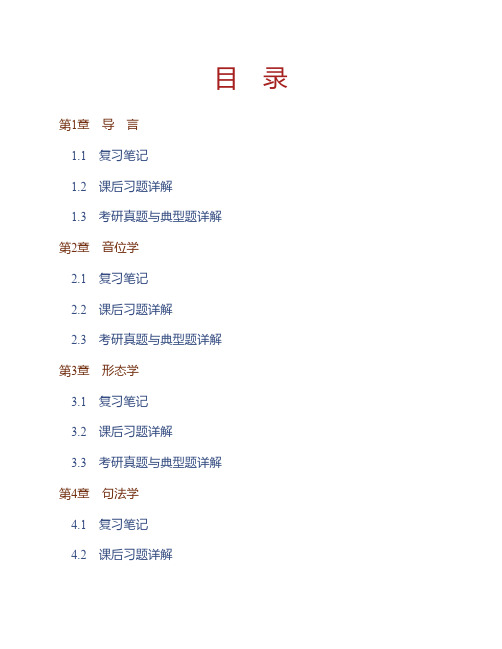
目 录第1章 导 言1.1 复习笔记1.2 课后习题详解1.3 考研真题与典型题详解第2章 音位学2.1 复习笔记2.2 课后习题详解2.3 考研真题与典型题详解第3章 形态学3.1 复习笔记3.2 课后习题详解3.3 考研真题与典型题详解第4章 句法学4.1 复习笔记4.2 课后习题详解4.3 考研真题与典型题详解第5章 语义学5.1 复习笔记5.2 课后习题详解5.3 考研真题与典型题详解第6章 语用学6.1 复习笔记6.2 课后习题详解6.3 考研真题与典型题详解第7章 语言变化7.1 复习笔记7.2 课后习题详解7.3 考研真题与典型题详解第8章 语言与社会8.1 复习笔记8.2 课后习题详解8.3 考研真题与典型题详解第9章 语言与文化9.1 复习笔记9.2 课后习题详解9.3 考研真题与典型题详解第10章 语言习得10.1 复习笔记10.2 课后习题详解10.3 考研真题与典型题详解第11章 第二语言习得11.1 复习笔记11.2 课后习题详解11.3 考研真题与典型题详解第12章 语言与大脑12.1 复习笔记12.2 课后习题详解12.3 考研真题与典型题详解第1章 导 言1.1 复习笔记本章要点:1. The definition and main branches of linguistics study语言学的定义和研究的范围2. Important distinctions in Linguistics语言学的一些重要区分3. The definition and the design features of language语言的定义与识别特征4. Functions of language语言的功能本章考点:1. 有关语言学的常考考点语言学的定义;语言学中几组重要区别,每组两个概念的含义、区分及其意义;普通语言学的主要分支学科及各自的研究范畴;宏观语言学及应用语言学的主要分支及各自的研究范畴。
戴炜栋《简明英语语言学教程》Chapter-4-Syntax
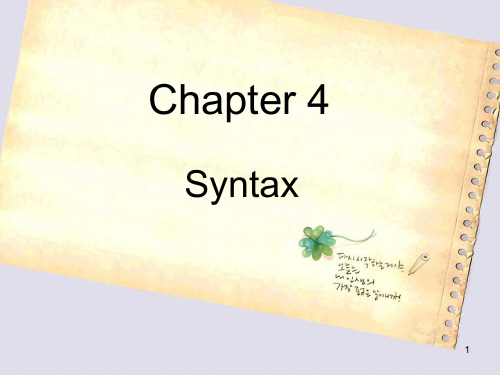
Syntax
1
4.1 What is syntax?
Syntax: (Greek) arrangement
A branch of linguistics that studies the
rules that govern the formation of
sentences.
➢ the composition of sentences: word-
22
4.3 Phrase structure rule 2. Coordination rule: Discussion: Can you lengthen the following sentences
by using coordinate structures ? John, _________________ liked the book. He washed his face, ________.
2
4.2 Categories Discussion: ➢ What can you fill in the context “The
________ is smiling.”?
3
4.2 Categories Discussion: Discuss the possible meanings of the
➢ complements: the words on the right side of the heads
15
4.3 Phrase structure rule
grammatical mechanism that regulates the arrangement of elements that make up a phrase
戴炜栋英语语言学概论Chapter-4

2021/6/4
17
Move a and constraints on transformations (移位a和转换的制约)
The general rules for transformations: a) Inversion can move an auxiliary from the Infl to the nearest C position , but not to a more distant C position . b) No element may be removed from a coordinate structure .
syntactic form of the sentence which results from appropriate transformations (通过恰当 转换而形成的句子的最终句法形式)
The two levels of structure are not always
different.
感谢您的关注!
XP rule
PP: (Deg) P (NP)…
Specifier 标志语
head 中心语
Complement 补语
2021/6/4
7
XP rule (XP 规则) P46
Four phrase structure rules NP: (Det) N (PP)… VP: (Qual) V (NP)… AP: (Deg) A (PP)… PP: (Deg) P (NP)…
Deep structure (深层结构): formed by the
XP rule in accordance with the head’s subcategorization properties (由XP规则按 照中心语的次范畴特征而构成的)
- 1、下载文档前请自行甄别文档内容的完整性,平台不提供额外的编辑、内容补充、找答案等附加服务。
- 2、"仅部分预览"的文档,不可在线预览部分如存在完整性等问题,可反馈申请退款(可完整预览的文档不适用该条件!)。
- 3、如文档侵犯您的权益,请联系客服反馈,我们会尽快为您处理(人工客服工作时间:9:00-18:30)。
Complements
---- Complements themselves can be a phrase, they provide information abut entities and locations whose existence is implied by the meaning of the head, e.g. a story about a sentimental girl. There can be no complement, one complement, or more than one complement in a phrase, e.g. p.48 (44)…(4-6) A sentence-like construction may also function as a complement such as in “I believed that she was innocent. I doubt if she will come. They are keen for you to show up.” “That/if /for” in the above sentences are complementizers(补语化成分), the clauses introduced by complementizers are complement clause.
Meaning: n. entities, v. action, adj. properties Ex. be aware of know about Inflection: n –s, v. –ed -ing, adj. –er -est Ex. a word belonging to more than one category Distribution: a/an n., be v-ed, be v-ing, Note: The most reliable criterion of determining a word’s category is its distrs and their structures
Phrase categories----the syntactic units that are built around a certain word category are called phrase categories, such as NP, VP, AP, PP. NP VP AP PP phrase level l l l l N V A P word level The structure: specifier + head + complement head(中心成分)---- the word around which a phrase is formed specifier(标志成分)---- the words on the left side of the heads complement (补足成分) ---- the words on the right side of the heads
Chomsky is much more interested in the similarities (language universals) between languages rather than their differences.
Linguists should attempt to find a grammatical framework which will be suitable for all languages; Linguists should concentrate on the elements and constructions that are available to all languages rather than on elements that actually occur in all languages. There are likely to be universal constraints on the ways linguistic elements are combined Chomsky proposed that the grammars of all human languages share a common framework (Universal Grammar).
S NP VP
S
NP Det A N boy V found VP NP Det the N evidence
Sentences (the S rule)
Chapter 4 Syntax
What is syntax?
----a branch of linguistics that studies how words are combined to form sentences and the rules that govern the formation of sentences.
Transformational Generative Grammar (TG) Norm. Chomsky, the most influential linguist in 20th century, some important works: (1957) Syntactic Structure; (1965) Aspects of the Theory of Syntax; (1981) Lectures on Government and Binding; (1986) Barriers (1993) A Minimalist Program for Linguistic Theory; (1995) The Minimalist Program; (1998) The Minimalist Inquiry……
Phrase elements
specifier (标志成分) head (中心成分) complement (补足成分)
specifiers
---- Semantically, specifiers make more precise the meaning of the head -----Syntactically, they typically mark a phrase boundary. Specifiers can be determiners as in NP, qualifiers as in VP and degree words as in AP.
The XP rule
XP
Specifier
X
Head
Complement
The XP rule: XP(specifier)X(complement) Note: The phrase structure rules can be summed up as XP rule shown in the diagram, in which X stands for N, V, A or P.
Coordination rule
Coordinate structures-----the structures that are formed by joining two or more elements of the same type with the help of a conjunction such as and, or, etc. ----Coordination has four important properties: no limit on the number of coordinated categories before the conjunction; a category at any level can be coordinated; the categories must be of the same type; the category type of the coordinate phrase is identical to the category type of the elements being conjoined.
Categories
Category(范畴)refers to a group of linguistic items which fulfill the same or similar functions in a particular language such as a sentence, a noun phrase or a verb. The most central categories to the syntactic study are the word-level categories (traditionally, parts of speech)
Phrase structure rules (PS-rule 段语结构规则)
The grammatical mechanism that regulates the arrangement of elements that make up a phrase is called a phrase structure rule, such as: NP (Det) + N +(PP)……e.g. those people, the fish on the plate, pretty girls. VP (Qual) + V + (NP)……e.g. always play games, finish assignments. AP (Deg) + A + (PP)……very handsome, very pessimistic, familiar with, very close to PP (Deg) + P + (NP)……on the shelf, in the boat, quite near the station.
